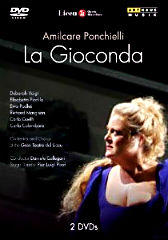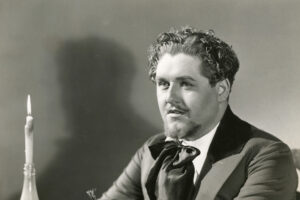
At one time, the idea of a performance of La Gioconda conjured up images of over-the-top, competitive, passionate vocalism, and big personalities. As a vehicle for great singers (and especially a great protagonist), it was thrilling.
Perhaps because this performance lacks the powerful personalities once thought essential, Pier Luigi Pizzi, director and designer of this production from Barcelona’s Gran Teatre del Liceu in 2005, tries to strip the work down to the essentials of the drama. This Venice forsakes ornate decoration and local imagery for simple design. A few staircases suggesting bridges and gondolas are all that indicate location on a set that is notable for its lack of color.
Life in this Venice (which the liner notes suggest is a century later than originally set, in the period just before the fall of the Venetian Republic) is a dull gray, with a persistent fog as if death has cast a pall on the city.
The constant gloom could be monotonous, but Pizzi breaks it up with well-placed splashes of red. The costumes mirror this palette with the exception of Gioconda’s blue dress. The blood red sails of Enzo’s ship contrast well with the overarching drabness and make a striking image as they are engulfed in flames.
Unfortunately the effective visuals are mired in an extremely static staging that robs the drama of any cohesion and reduces much of it to a series of poses.
Richard Margison, looking more menacing than amorous, moves stiffly as Enzo, rarely indicating any real emotion or involvement. Vocally he is efficient, with an appropriately sized and well-produced voice, but one lacking any intrinsic beauty or Italianate style. He seems uninterested in connecting with, or even looking at anyone onstage except for the awkward moment when he and Elisabetta Fiorillo (Laura) embrace at the end of the love duet (and have difficulty positioning themselves correctly.) Not that Fiorillo offers much as his lover. Her mezzo is uneven and squally, and she offers little in the way of physical characterization other than occasionally repositioning herself and gesturing aimlessly.
The lower voices fare better. The direction of Carlo Guelfi’s Barnaba leaves him little room for any but the most awkward gestures (in the final scene he is positioned so far downstage from Gioconda he is forced to offer his advances from over his shoulder.) But at least his snarling baritone offers the right Italianate quality and his inability to sing legato is less of a deficit than it is in Verdi. Carlo Colombara as Alvise offers a well-produced bass of modest size and an appropriate musical style dripping with venom.
Ewa Podle? as La Cieca briefly offers a reminder of what a performance of Gioconda was once about. Although not necessarily in the best vocal estate, she nevertheless throws herself into the drama both physically and vocally with full commitment. She is the trooper as she is literally thrown about the stage as the sailors accuse her of witchcraft in the first act.
And then there is Deborah Voigt in the title role. She starts at a disadvantage. Hers was never the ideal quality for this music and the middle of her voice has lost the plushness that it once had (this performance was post-surgery). Yet the top is solid and while she doesn’t really live Italian style, she approaches the role with abandon. While in the past I’ve found her performances unemotional and with a lack of involvement, no such charge can be leveled at her here. Hampered by the context of the production, she succeeds in offering a committed characterization and generally secure vocalism. Is it a Gioconda for the ages? No, but it is a very fair stab at it with the considerable resources that she has available.
The chorus, although it sings well, lines up dutifully on the staircases as if entering Avery Fisher Hall to sing Messiah. Close ups reveal individuals registering a minimum of distraction or involvement in what is happening on stage.
A highlight of the performance is the semi-nude but effective Angel Corella in the “Dance of the Hours” ballet. In the pit Daniele Callegari handles the orchestra with style, although whoever directed the video might have opted not to include a shot of the orchestra members chatting while the music is being played.
So is this what La Gioconda has become in the twentieth century? With more apt vocal equipment Voigt may have become a great Gioconda. As it is, this video is a pale reminder of why Ponchielli’s opera was once a thrill for lovers of great singing.



























Comments